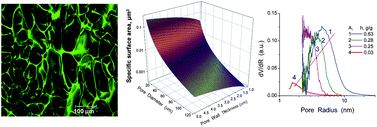Porous structure and water state in cross-linked polymer and protein cryo-hydrogels†
Abstract
The porous structure and the state of the

* Corresponding authors
a
University of Brighton, Brighton, UK
E-mail:
i.n.savina@brighton.ac.uk, v.gunko@brighton.ac.uk, s.mikhalovsky@brighton.ac.uk
Tel: +44 (0)1273 642015
b
Chuiko Institute of Surface Chemistry, 17 General Naumov Str., Kiev, Ukraine
E-mail:
vlad_gunko@ukr.net, v_turov@ukr.net
Fax: +38044 4243567
Tel: +38044 4229627
c
Protista Biotechnology AB, PO Box 86, Lund, Sweden
E-mail:
maria.dainiak@protista.se
Fax: +46 286 38 89
Tel: +46 286 38 82
d
DSM Food Specialties B.V., PO Box 1, Delft, The Netherlands
E-mail:
igor.galaev@dsm.com
Fax: +31 152794110
Tel: +31 152793771
The porous structure and the state of the

 Please wait while we load your content...
Something went wrong. Try again?
Please wait while we load your content...
Something went wrong. Try again?
I. N. Savina, V. M. Gun'ko, V. V. Turov, M. Dainiak, G. J. Phillips, I. Yu. Galaev and S. V. Mikhalovsky, Soft Matter, 2011, 7, 4276 DOI: 10.1039/C0SM01304H
To request permission to reproduce material from this article, please go to the Copyright Clearance Center request page.
If you are an author contributing to an RSC publication, you do not need to request permission provided correct acknowledgement is given.
If you are the author of this article, you do not need to request permission to reproduce figures and diagrams provided correct acknowledgement is given. If you want to reproduce the whole article in a third-party publication (excluding your thesis/dissertation for which permission is not required) please go to the Copyright Clearance Center request page.
Read more about how to correctly acknowledge RSC content.
 Fetching data from CrossRef.
Fetching data from CrossRef.
This may take some time to load.
Loading related content
